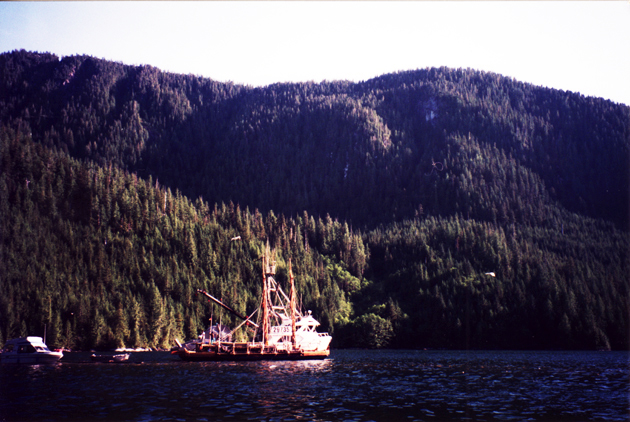Hawai‘iloa’s Northwest-Alaska Journey / May-July 1995
Dennis Kawaharada
In May-July 1995, the voyaging canoe Hawai‘iloa journeyed from Seattle, Washington, to Juneau, Alaska.

Hawai‘iloa participated in cultural and educational exchanges in Seattle, Vancouver, B.C., and Juneau, as well as towns and villages along the way. The canoe stopped at Hollis on Prince of Wales Island, west of Ketchikan, Alaska, where the two Sitka spruce trees used for her hulls originally came from. SeAlaska, a corporation owned by the Tlingit, Haida, and Tshimshian tribes, donated the logs to the native people of Hawai‘i for building the canoe.
The mission of the voyage was to express appreciation to SeAlaska and its member tribes for their generous gift. PVS hoped to bring pride and honor to the peoples of Alaska by showing them that their Sitka spruce logs have a new life in assisting us to recover voyaging traditions.
On this journey, the Polynesian Voyaging Society planned to:
- participate in cultural exchanges with native peoples, particularly with those who depended on ocean and forest resources and canoes for survival. Events included the traditional welcoming of the canoe at each village; potlatches; and singing and dancing performances.
- share information and educational materials on the values, practices, and arts (including canoe building) that enabled the first peoples of the Pacific and the Pacific Northwest to survive successfully in their environments for centuries and to insure the health and productivity of their lands and seas for future generations. Slide shows and canoe tours were conducted by crew members.
- Document the journey to educate students and the public in Hawai'i and nationwide about how native peoples in different part of the world are facing similar cultural and environmental challenges and what steps they are taking to meet these challenges.
Hawai‘iloa
On July 24, 1993, a beautiful new Hawaiian voyaging canoe was launched at Pier 36 in Honolulu Harbor. The canoe, named Hawai'iloa, took two years to build. At first, the plan called for building the canoe out of indigenous materials of Hawai'i in order to re-learn ancient canoe building arts; the hulls were to be carved from koa logs. (See “The Building of Hawai'iloa.”)
However, after a nine-month search in 1989-90, we discovered that the forests of Hawai'i no longer had koa trees large enough for the hulls of a voyaging canoe. Over the years, the forests had been cut down for lumber and to clear land for cattle ranching. (See “Sacred Forests” by Sam Low.)
When Byron Mallot, CEO of the Sealaska Corporation, heard of Hawai'i's need for logs to build a traditional voyaging canoe, he offered to donate two Sitka spruce trees. Two trees, 200-feet tall, eight feet in diameter, and over 400 years old, were found on Shelikof Island in Soda Bay, Prince of Wales Island, west of Ketchikan, Alaska.
Traditionally, Hawaiians used drift logs from the Pacific Northwest to make canoes. Menzies, a surgeon and naturalist accompanying Captain George Vancouver to Hawai'i, reported in 1793: "the largest single canoe we had seen amongst these islands [was] about sixty feet long and made of one piece of the trunk of a pine tree which had drifted on shore on the east end of the island of Kaua'i a few years back." Hawaiians considered these logs gifts from their gods.
The two 66-foot, 25 ton spruce logs for Hawai'iloa came by ship rather than on the ocean currents. The gift highlighted the possibility and the need for native peoples to work together in their efforts to maintain their cultural traditions in the modern world.

Seattle-Vancouver, May 27-May 30
In Feburary-May 1995, Hawai‘iloa completed her first voyage, from Hawai‘i to Tahiti and the Marquesas Islands and back, a 6000-mile, 3-month long journey. Two days after arriving home in Hawai‘i, she was shipped with Hokule‘a, who sailed with her to the South Pacific, to Seattle, arriving in Seattle on May 19.
Hawai‘iloa left Seattle for Vancouver on May 27 with a stop at Bellingham. The crew was hosted by native Hawaiians living in the area, as well as the Coast Salish tribes of Lummi, Suquamish, and Musqueum.
On June 12, Hawai‘iloa headed north to Juneau, and Hokule'a south to Oregon and California.
Hawai‘iloa Crew, Seattle to Vancouver
- Chad Baybayan: Captain; veteran navigator. Kailua-Kona, Hawai'i
- Snake Ah Hee: Veteran crew member from Lahaina, Maui.
- Junior Coleman: Crew member, 1995 Voyage. Honolulu, HI.
- Terry Hee: Veteran crew member. Towing specialist. 'Aina Haina, Oahu.
- Jerry Monahan: Pilot. Seattle, WA.
- Mel Paoa: Veteran crew member. Moloka'i.
- Sam Pautu: Crew member, 1995 Voyage. Ua Pou, Marquesas Islands.
- Mau Piailug: Master navigator. Satawal, Caroline Islands, Micronesia.
- Gary Suzuki: Crew member, 1995 Voyage. Lana'i.
Vancouver, May 31-June 12
In Vancouver, the canoe was docked at the Maritime Museum, with the crew giving tours of the canoe and preparing the canoe for the journey north.
One visitor was Frank Brown, a canoe carver, who arrived with two videos he wanted to share about the canoe revival going on in the coastal villages of British Columbia. He said that the crew needed to know the protocol of canoe travel up the coast since we were bringing a canoe; and also which canoe builders to talk with at each stop. The PVS protocol for the British Columbia portion of the voyage was being handled by Hutch Hunt, a Kwagiutl fisherman from Fort Rupert, and his daughter Christine.
Brown was with a Haida woman from Masset, on Haida Gwaii (Queen Charlotte Islands), who invited the canoe to visit her home island 80 miles west of Prince Rupert, across Hecate Strait. “It’s the most beautiful part of British Columbia,” she explained. She was disappointed that the island was not on the schedule of stops. “You should come,” she said again. Haida Gwaii is the center of a Haida cultural revival.
Another visitor was a woman from Vancouver Island who was part native American, part Hawaiian. She spoke with crew member Hauoli Smith about the impending desecration of a traditional burial site on Vancouver Island by a builder planning to put up a condominion project. The natives were planning a protest. Hauoli was sympathetic – native Hawaiians have to battle with the same kinds of outrages in Hawai’i.
On the night before departure, the crew had dinner with the crew of the escort/tow boat Marc Alan, a 58-foot seine boat out of Vancouver owned by Hutch Hunt. Hunt, who had been a visitor to Hawai'i for the past 25 years, knew the dangerous narrow passages among the dozens of forested islands along the coast. Navigating in these waters requires a knowledge of tidal shifts of 15-20 feet, 15 knot currents, and swift-changing weather. Drifting logs, hidden rocks, and heavy boat traffic are other hazards. Timing the movement of the vessels to the tides and weather made for odd departure times and stops along the way.
Hutch and his first mate/captain Ross Dennis Hunt are descendants of George Hunt, of English and Tlingit parentage, who was raised in the Kwaguitl town of Fort Rupert and who married a Kwaguitl woman. For forty years around the turn of the century, George Hunt worked with anthropologist Franz Boas, documenting the language and traditions of the Kwaguitl.
Ross was a teacher and printmaker. He told us that he got permission from his father and mother to share their knowledge of Kwaigutl culture with others. His grandmother advised him that to tell both the good and the bad, not just the good about Kwaguitl traditions.
Hawai‘iloa Crew, Vancouver to Ketchikan
- Bruce Blankenfeld: Captain; veteran navigator. Niu Valley, O'ahu
- Nainoa Thompson (From Port Hardy to Ketchikan): Project Director for Hawai‘iloa; veteran navigator. Niu Valley, O'ahu.
- Brad Cooper: Watch-captain, teacher of Hawaiian Studies at Kamehameha Schools in Honolulu. Crew member,1995 voyage. Kaneohe, O'ahu.
- Hauoli Suzette Smith: Watch-captain, veteran sailor; member of America's cup all-women team, 1995. Honolulu, O'ahu.
- Aaron Young: Watch Captain, fireman. Niu Valley, O'ahu.
- Bob Bee: Crew member. Honolulu, O'ahu.
- Tia Blankenfeld: Bruce's daughter; first voyage.
- Junior Coleman: Crew member, 1995 Voyage. Honolulu, O'ahu.
- Terry Hee: Veteran crew member. 'Aina Haina, Oahu.
- Tom Huska: Bruce's friend. Vancouver, B.C.
- Dennis Kawaharada: Media and documentation; Polynesian Voyaging Society staff. Asst. Professor at Kapi'olani Community College. Crew member on interisland voyages. Makiki, O'ahu
- Ka'au McKenney: co-navigator on Hokule'a, 1995 voyage from Hilo to Tahiti; crew member 1995 voyage from Nukuhiva to Hawai'i. Palolo Valley, O'ahu.
- Jerry Monahan: Pilot. Seattle, WA
- Brad Quinto: Crew member. Honolulu, O'ahu
- Kaikane Young: Aaron Young's son; first voyage
Crossing to Vancouver Island, June 12
On June 12, Hawai‘iloa was towed by Marc Allen 95 miles up the Strait of Georgia and the Malaspina Strait, tucking into a bay on Hernando Island and spending the night there to wait for the tide to slack. At 3 am, with the sky already getting lighted, Hawai‘iloa departed for Campbell River, about 18 miles away.
Campbell River, June 13
Hawai‘iloa arrived at Campbell River at 5 in the afternoon and was met by two cedar canoes. After a dockside welcome, the crew went to a gym at the Wei Wai Kum village for a welcoming dance performance and dinner, with native foods that included salmon, halibut, eulachon (a small fish), cockles, herring eggs, and seaweed. Such gatherings, called potlatches, are modern versions of the traditional potlatches of the Northwest coast.
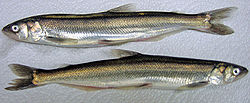
Eulachon (also spelled oolichan) are also called candlefish because their bodies contains so much oil during spawning, they can be lit as candles. Besides being eaten cooked, dried, or smoked, the fish was decomposed and boiled in water, so the oil could be skimmed. Natives drank the pungent oil and added it to other food. The tribes with eulachon rivers traded the fish and oil with tribes that didn't have access to such rivers. The appearance of eulachon marked the beginning of spring and a renewed food supply after winter.
The dance performance at Wei Wai Kum was the Hamatsa, featuring a Wild Man wearing a skirt of cedar bark and large rings braided from cedar bark draped over the shoulders. Accompanied by two women, he entered the gym crouched over, head turning, eyes darting, and uttering inarticulate cries. He circled the floor. Later, three men with large wooden bird masks appeared, representing supernatural cannibal birds. One of the masks had a crooked beak, the other two long pointed beaks – to peck open the skull of a person and eat his brains. At the end, a line of women dancers, dressed in blankets and beating drums came forth. The singing and dancing tamed the Wild Man, making him human again and bringing him back into society.
The Hamatsa dance in traditional times initiated a person into the secret Hamatsa society. The story enacts the adventures of a man (or brothers) who met a supernatural cannibal spirit named Baxbaxwalanuksiwe (also “Bakhbakwalanooksiwey”). This cannibal spirit was accompanied by the three cannibal birds whose are represented by the dancers with masks. (See photos at Fort Rupert below.) The man killed the cannibal spirit and brought back to his family the dances he had learned from his encounter with mystical powers.
During this winter ceremony, an initiate into the ancestors’ experience was isolated for a while, to relive the experience of the ancestor, then returned to the village in a wild state and was brought back into society by the dance performance.
The Hamatsa was performed later at Alert Bay, Fort Rupert, and Bella Bella, with the Kwaguitl and Heiltsuk tribes. After we entered Tlingit territory in SE Alaska, the Hamatsa was no longer done. When I asked Nathan Jackson, a Tlingit master carver from Klukwan, why this was so, he said that it was dangerous to delve into dark, mysterious traditional practices associated with shamanism. Being devout Christians, he and other Tlingits avoid engaging in traditional shamanistic practices.
Speeches follow the Hamatsa performance at Wei Wai Kum, then gift-giving: t-shirts, caps, and small wooden paddle pendants. Traditionally, these gifts were payment from the hosts to the guests for witnessing a village’s display of wealth and privilege.
The Hawai‘iloa crew presented a program of Hawaiian dances and presented gifts to the elders of the tribe.
The next day, outside Hill’s Indian Craft store, a Kwagiutl named Frank struck up a conversation with us. He was critical of the display of his culture inside the store. “We’re showing too much of ourselves to tourists. We need to keep more of it inside.” He said that his brother “went wild” – into the woods to meet with the supernatural, as in the old days. Traditionally, this was done by someone preparing to become a shaman. Through his encounter with the supernatural, he would gain the power to foretell the future, identify witches responsible for causing illness, and cure the illness. His brother emerged from the woods after four days. Frank hadn’t spoken to his brother about what happened in the woods. Before leaving, Frank told us he had a line of t-shirts which he sold through craft stores in towns on Vancouver Island.
On the way back to the canoe, I stopped at the Campbell River Visitor Information Center to inquire about the spelling of the name of the village that hosted us the night before. The young woman at the front desk didn’t know how it was spelled. She picked up a directory to try to find out, without success.
Alert Bay, June 14-15
After a night at Little Bear Bay, waiting for the tide to slack, Hawai‘iloa arrived on June 14 at Alert Bay, on Cormorant Island, 100 miles up Discovery Passage and Queen Charlotte Strait. A cedar canoe with a cormorant painted on its prow paddled out to greet the voyaging canoe.

Aaron Young watching the cedar canoe approach at Alert Bay
Chief Alfred West, dressed in ceremonial regalia, was invited aboard Hawai’iloa. He was affable and comfortable aboard the canoe, being a canoe builder himself. He took a turn at steering, then talked about his life and times. He said that he was sent to the government boarding school at Alert Bay to be assimilated. There, he was forbidden to speak Kwagiutl. When he returned to his village, he was considered smart, but his understanding of the traditional culture was much weaker than his peers. He talked about the differences between life today and life when he was a boy, lamenting the loss of traditional fishing grounds between Alert Bay and Vancouver Island. He said the cod had been overfished and the salmon spawning streams had been ruined by logging.
The conflict between traditional and modern uses of resources is ongoingin the Northwest, as in Hawai'i, with traditional uses and conservation losing ground to completing commercial interests. That summer, there was a commerial fishing war going on between the Alaskans and Canadians. The Canadians wanted the Alaskans to reduce their quotas on fishing. In the logging industry the debate was over clear-cutting and managed cutting to protect the forests and the streams.
At Alert Bay, the Hawai‘iloa crew attended a celebration of a negotiated agreement with the provincial government to move a road built over an ancestral burial site. Two totems pole – Halibut Man and Eagle – were unveiled to commemorate the agreement.

Halibut Man
That afternoon, the crew went to a potlatch at the Long House, outside of which stood a 160-foot tall totem pole with an eagle perched at the top.

Drummers at Alert Bay
The gathering included a Salmon Prince and Princess competition to honor a young boy and girl for their knowledge of the native language and culture. Chief Bill Cranmer, director of the U’Mista Cultural Center in Alert Bay, told the crew the story of how the Center was created from a struggle to bring back to the community sacred masks and coppers that had been confiscated by the govemment and placed in a museum in Montreal after potlatches had been outlawed. Moved by the strength of cultural revival of the Nimpkish people, Captain Bruce presented the Cultural Center with one of the paddles that made the journey with Hawai‘iloa to Tahit and, Nukuhiva.
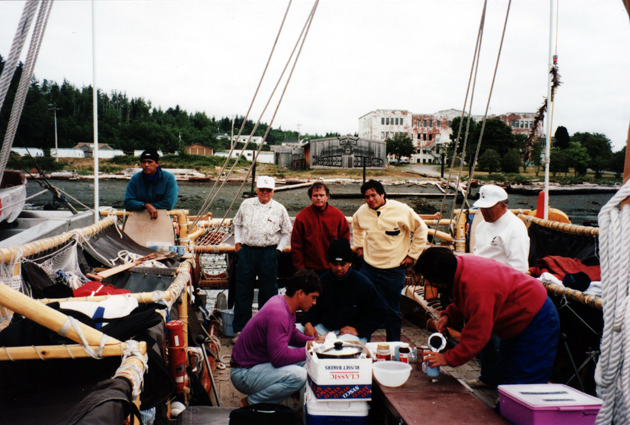
Bruce meeting with his crew at Alert Bay
Port Hardy and Fort Rupert, June 16-18
The voyaging canoe Hawai‘iloa arrived in Port Hardy, Vancouver Island, on Friday, June 16, for a three-day stay. Chief West was a guest on board for the 27 mile tow.
A delegation of the crew, led by captain and navigator Bruce Blankenfeld, went ashore for a formal greeting ceremony. That evening the crew was invited to the Big House at Fort Rupert for a potlatch.

The Big House at Fort Rupert
Inside the Big House a cedar fire blazed for the presentation of the Hamatsa story, that had been presented by the Wei Wai Kum tribe in Campbell River.

Crooked beak, one of the cannibal birds in the Hamatsa mythic cycle.
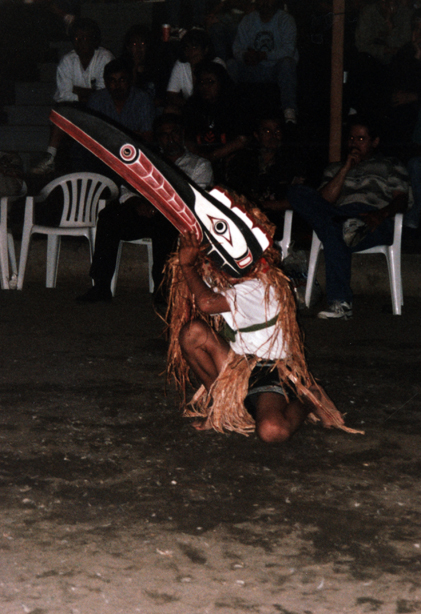
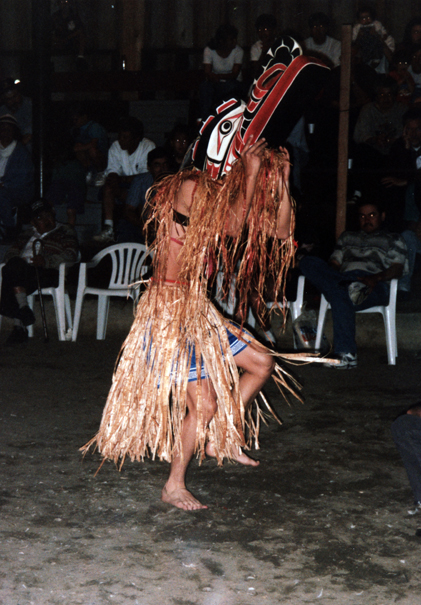
Following the Hamatsa performance, a communal dance took place in which the audience joined.

Ross Dennis Hunt joined in the dancing

Hutch Hunt, escort boat owner addressed the crew and natives, with his daughter Christine, with Laura Thompsonm crew member Hauoli Smith, and captain Bruce Blankenfeld.

Bruce at Port Hardy. Sunset on June 16 at 9:45 pm.
The weather was chilly, down to the 40's, particularly on the water. The northwest wind can make it even colder, forcing crew members into layered cold-weather gear as they stood watch on the open deck of the canoe. But the journey was full of rewards – making new friends, exchanging cultural information, and lending support to revivals of native cultures along the coast. The Hawaiian crew found much in common with the native peoples – not just canoe-building traditions, but also the values of hospitality and sharing, reverence for ancestors and family, and caring for the environment.
On Sunday, June 18, Hawai‘iloa left on a 116-mile journey north to Bella Bella.
Bella Bella, June 19-20
Someone had advised us against going to Bella Bella because of the town’s high rate of alcoholism and other social problems. The visit, however, was a great success. A canoe paddled out to greet Hawai‘iloa.
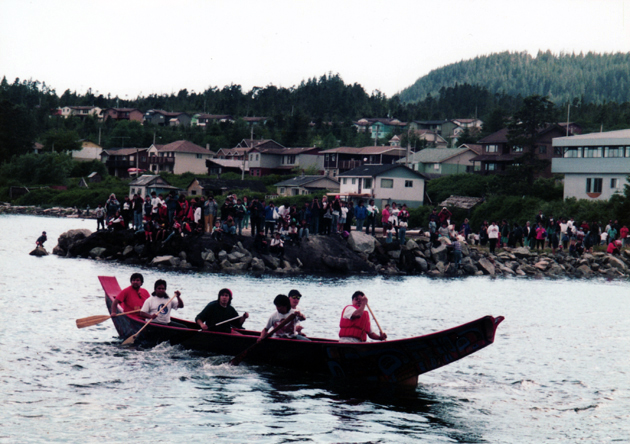
Bella Bella canoe paddling to greet Hawai‘iloa
The gym was packed for the potlatch. Traditional gifting and sharing are alive in the native communities. The crew received gifts of traditional foods (salmon, halibut, a large bag of tasty dried seaweed), along with caps, t-shirts, towels, and pendants. The tribe offered money for traveling expenses. It's an insult to refuse. The crew reciprocated with Hawai‘iloa t-shirts, caps, and sweaters and with canoe tours. But there was no way to repay the hospitality. You say thank you and feel indebted.
There is a friendly and traditional competition in giving among the tribes. When Christine Hunt of the Kwakuitl, who organized the British Columbia tour of Hawai'iloa with her father Hutch, heard about the generosity of the Heiltsuk in Bella Bella, she laughed, "The Heiltsuk have outdone us again."
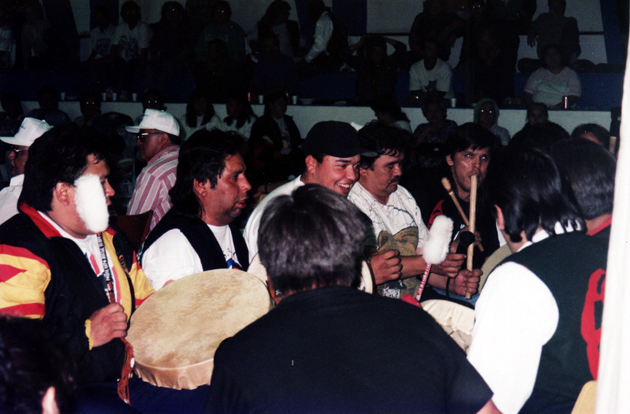
Bella Bella drummers; escort boat first mate Ross Hunt joined in the drumming
Hauoli Smith, a Hawai'iloa crewmember who recently competed for America's Cup with the Women's Team shared her feelings at a crew talk-story session. "I haven't laughed so much in a long time." The family feeling among the crew and the hospitality of the hosts have lightened her spirits after the intense, grueling competition to win the right to defend the Cup in San Diego. "I've been waiting for one big revelation on this journey, something like thunder, but it hasn't come. It's subtler. It's a series of small unforgettable moments."
After Hauoli performed a hula at Bella Bella, accompanied by crew member and Kamehameha School teacher Brad Cooper on ipu, a fan club of pre-teen girls formed around her and stayed with her for the rest of the evening, explaining the traditional dances of the Heiltsuk. An old woman gave her an engraved silver bracelet as a gift.
Sailing in the Tolmie Channel near Butedale on the way to Prince Rupert
Bishop Bay, June 20
Hawai‘iloa and Marc Allen stop at Bishop Bay where there is a hot spring.
Lowe Inlet, June 20

Hawai‘iloa and Marc Allen. Overnight Stop at Lowe Inlet
Prince Rupert, June 21-24
At 8 p.m. and the sky over Prince Rupert was still as bright as early afternoon. Hawai'iloa docked at this city on June 21 after a 200-mile journey from Bella Bella, with an overnight stop at Lowe Inlet. The crew gathered on the deck for an informal meeting and a late dinner. Emmsley Bolden, spokesman for the Tsimshian chiefs, greeted the crew dockside in the evening. Visitors were still dropping by.
"Do you believe in eagle feathers?" an elderly Haisla asked Captain Bruce.
"We don't have eagles in Hawai'i, but I believe in the symbolism of the eagle for your people." The old man, who told us he was a recovered alcoholic, left and returned a short time later with a fan-like ceremonial piece made from seven eagle feathers. The handle was adorned with beautiful beadwork done by his wife. He presented the feathers to Bruce. "It's been blessed by a medicine man. Bring it out when you need good luck on your voyage," he explained quietly.
A chief from Kitanmaks, 125 miles inland from Prince Rupert, also presented Bruce with eagle feathers.
Off to the side a carver from Haida Gwaii (Queen Charlotte's Island) was showing crew member Ka'au McKenney drawings of traditional crest designs. There are over 700 crests among the Haida, some, like the hummingbird, can be used by anyone; others are owned by particular families. The carver pulled a mask out of his backpack – raven transformation mask, adorned with human hair. Then a rattle. He brought out his tools, demonstrated how to use one of them on the back of the mask, and gave the tool to Ka'au.
We had entered what was traditionally Tshimshian country, which stretches back into the continent along the Skeena River. The Tshimshian have been here for thousands of years. They are credited with developng the form-line art style that has become characteristic of North Pacific coast native art.
In the 19th century a lay missionary named William Duncan settled among the coastal Tshimshian and learned their language. Duncan set up a cooperative Christian community named Metlakatla, and ended up converting the high chief Legex and most of the Tshimshian nation to Christianity. Later the community was moved to an island just south of Ketchikan. Duncan is greatly resented today by young natives seeking to revive their culture.
The next day, a Nisga’a woman named Arlene met us at the museum. The Nisga‘a are from the Nass River valley, north of Prince Rupert, near the border of British Columbia and Alaska, with a population of about 6,000, 2,500 still living in the Nass valley, and 3,500 outside. Arlene cut into the narrative of the guide at the museum, where no natives work. She talked about the need for unity among native people. The crew followed her, leaving the other tourists with the museum guide.
Arlene told us about the origin of her people and gave us a book of photographs published by the Nisga‘a Tribal Council documenting their story, with the hope that Hawai‘iloa would return one day and visit Nisga‘a territory. The introduction by Frank Calder states:
We are Nisga‘a – the people who live in the Nass River valley of northwestern British Columbia and claim it as our territory. We intend to live here in the Nass forever.
The river and its watershed – from glacial headwaters to Pacific estuary – provided the food, fur, tools, plants, medicine, timber and fuel that enabled us to develop one of the most sophisticated cultures in North America.
The origin story tells of a flood, with ancestors “surviving on rafts lashed to the mountain tops.” The trickster Txeemsim (sometimes identified as Raven) came from heaven. While capable of mischief, he also did good things. He brought fire. He brought eulachon to the Nass river; he threw a mountain into the channel to protect the Nisga‘a from their traditional rivals, the Haida and Tshimshian. He leveled a valley between mountains for houses. He shaped the river channels so more salmon could spawn. He taught the people to value their sacred lands and to be resposnible for them. “Over and over, Txeemsim's life proves that selfish behaviour is ultimately destructive for both self and society.”
Later the crew visited the workshop behind the musuem, where a master carver was working on a totem pole. The master carver was not there, but an apprentice, a tall young Haida named Lyle gave us a tour and talked about Haida art. He explained the significance of the two main colors – red for life, black for power. He talked about the crests used in the art – the Eagle, Raven, Killer Whale. These are real animals, but some, like the sea wolf or the sea raven are mythical, he explained.
Lyle was working on a small argillite statue of a killer whale, with abalone shell inlays, using what looks like a dental drill as a carving tool. The statue is intricately beautiful. Argillite stone is available only from a quarry on Haida Gwaii. Lyle says he has a buyer for the piece, for $2,500. Kim Guerin, of the Musqueam tribe, whom we met in Vancouver and who later flew to Prince Rupert to join the crew, told him that he could get more for it in Vancouver. The market for native art is strong.
Later Lyle appeared at the Prince Rupert dock in a cedar canoe from Haida Gwaii, with a beautifully carved raven’s head on the prow. There were no native canoes in Prince Rupert, so the canoe was ferried over from Haida Gwaii. Later the Haida crew took Bruce and Wally for a ride in the canoe. A visitor to Hawai‘iloa from Haida Gwaii who was studying to be a teacher in Prince Rupert and wanted to teach Haida traditions back on Haida Gwaii, said she heard that the cedar canoe was hoping to paddle alongside Hawai’iloa to Ketchikan.
On Saturday, June 24, the Tsimshian Tribal Council of Prince Rupert along with Tsimshian, Nisga'a, and Haida dancers formally welcomed the canoe and crew with an event at Chatham Longhouse. The Lach Klan Society hosted a feast in honor of the canoe.
Nainoa Thompson, head of the Hawai‘iloa project, joined the crew in Prince Rupert for the rest of journey north to Juneau.
Port Simpson, June 24
On our way to Saxman and Ketchikan, Hawai‘iloa planned to tow past Port Simpson, formerly a trading post run by the Hudson Bay Company, now a Tshimshian village. In the 18th century, the Tshimshian abandoned some of their traditional winter villages and moved to the trading post.
As the canoe neared the town, 26 norht of Prince Rupert, however, our new escort/tow boat, piloted by a Tshimshian fisherman from Port Simpson, radioed to inform us we would be stopping at the town after all. We arrived there in the late evening. Later, Ernie Hillman, the Tlingit guide who met us in Prince Rupert, told us that the new escort boat had “kidnapped” the canoe and brought her to his home town. A hundred or so children were waiting at the dock to greet the canoe and after Bruce gave them permssion, they came aboard. Curious about everything, they gathered around the different crew members asking questions.
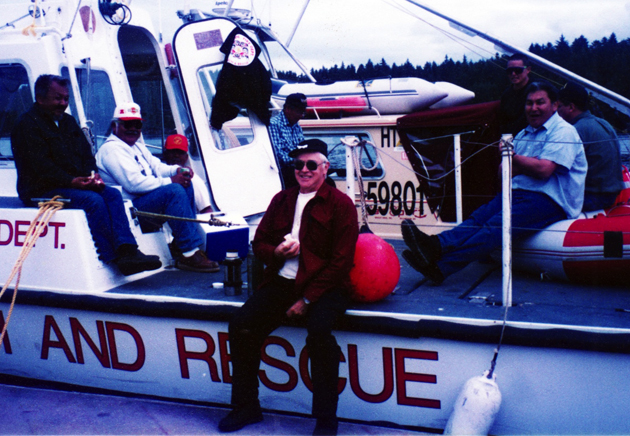
Ernie Hillman
One of the girls, a cute, chubby 7 or 8 year old, asked me what American money looked like, and when I showed her a five dollar bill, she took it and hid it behind her back. I could tell by her mischievous smile that I wouldn’t get it back. “It’s not worth anything, anyway,” she laughed. “It’s worth more than Canadian money,” I replied. More kids started asking to see what American bills looked like. When I told them no, they shot back, “Why, you showed one to Gina!” One of them whispered to me, “Gina’s the baddest girl in town.” Another told me about a boy in town who shot his brother, then later tried to commit suicide by hanging himself.
When some crewmembers went for a walk through town, about thirty children followed them. The crew members looked like pied pipers. Later, I took a stroll into town with another crew member. There were a dozen eagles roosting on rocks along a twilit cove. A raven was perched on the gable of a house. A couple of the kids followed us up the street through town to the grocery store, where we bought them ice cream. “What would you be doing if the canoe weren’t here?” I asked. “Watching TV at home,” one of them answered. Later, as we walked back to the canoe, we saw Gina eating an ice cream cone. “I got six Canadian dollars for the five,” she informed me, smiling.
That night, a pilot boat from Ketchikan showed up to tow Hawai‘iloa across an open stretch of ocean in the Dixon Entrance, 75 miles to Saxman. After a good night’s sleep, we departed at 4 am, the skies partly cloudy. Luckily, the ocean was calm, only a long small smooth swell rolling in from the NW.
Saxman-Ketchikan, June 25-27
Saxman is a Tlingit village three miles south of Ketchikan. The cloudy skies began clearing slowly as the canoe was towed up Tongass Narrows, and it was bright and sunny when Hawai‘iloa reached Saxman, which are built on the shore of spruce-covered hills, with snow capped mountains in the distance.
Arriving at about twelve noon, Hawai'iloa was greeted by people lining the shore, waving, and honking their car horns. Native elders and dancers of the Tlingit, Haida, and Tsimshian nations greeted the Hawai‘iloa crew on shore.
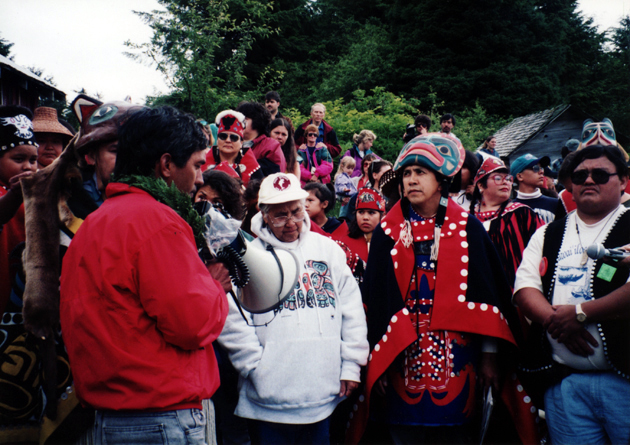
Nainoa Thompson (with microphone), who joined the crew in Prince Rupert for the journey to Juneau, and canoe carver Richard Jackson (in regalia), who welcomed Hawai‘iloa to Saxman.

Members of a hula halau from Anchorage joined Bob Bee and Hauoli Smith at the steering sweep.
That night, over a thousand guests gathered at Saxman Community Hall for a feast, speeches, and entertainment that lasted till 1 a.m. The visit of the canoe had created great aniticpation in the community. "We prayed for good weather," one elder said. "When we saw the canoe coming, my grandson started shouting, 'They're coming! they're coming!"'
Richard Jackson, a Tlingit leader who helped organize the reception in Ketchikan, noted that a pod of killer whales, traditional guardians of the Tlingit nation, came through Tongass Narrows earlier in the day, "opening the way for the canoe to enter Alaska and travel onto Juneau. The canoe symbolizes the bond between our people. The visit is a celebration of our cultures."
Nainoa Thompson, director of the Hawai‘iloa project, explained the purpose of the visit: to thank the people of Alaska and show them that "the promise to build a canoe out of the logs donated by Sealaska has been fulfilled. This visit is the culmination of a five-year project begun in 1989 to build a voyaging canoe out of traditional materials."
During a slide presentation about the 1995 voyage of Hawai‘iloa to the Marquesas Island, Thompson praised the leadership of Judson Brown, a member of the Board of Trustees of Sealaska Heritage Foundation, in getting the logs to Hawai'i. He compared Brown's contribution to the project with the contribution of Mau Piailug to the revival of non-instrument navigation: "The canoe could not have been built without Judson's help," Thompson noted.
Brown responded, "We gave you wood to help you make your journey to your ancestral homelands. You gave us much more. You have shared with us your civilization, your spirit, your dreams. You have taught us that we can strive for and achieve the same kinds of things in the revival of our civilization."
Willard Jackson of the Tlingit tribe, who was invited to ride on the canoe after it entered Tongass Narrows, said that the visit of the canoe has brought the three native nations in the area together in celebration. "I felt a peace on board the canoe this morning as it went through the calm waters. I felt the unity of the four nations--the Tlingit, the Haida, the Tsimshian, and the Hawaiian.
A performance by the Cape Fox dancers closed the evening. Sixty members strong, the group drummed, chanted and danced, filling the large hall with stately rhythms and a religiously mystical mood. The traditional performances included the Dance of the Killer Whale and the Welcoming of the Chiefs, in honor of Thompson and Hawai'iloa Captains Bruce Blankenfeld and Wally Froiseth. The colorful, fringed Chilkat blankets swayed, the white fur caps with ermine tails flying and the wooden masks of ravens, eagles, bears, and wolves bobbed as the dancers spun and dipped on stage.
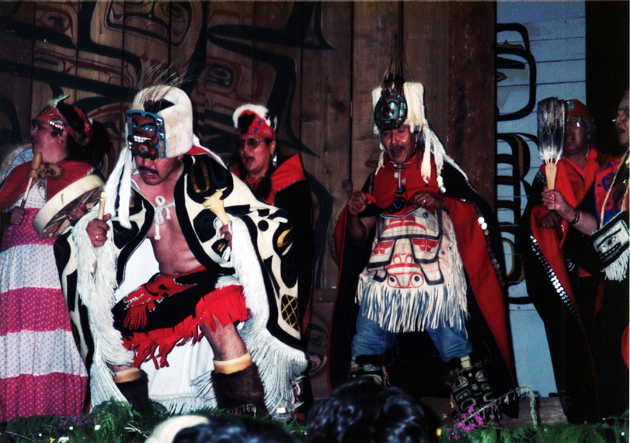
Cape Fox Dancers

Captain Wally Froiseth and crew member Ka'au McKenney Catch a Ride on a Haida Canoe
Hawai‘iloa Crew, Ketchikan to Juneau
- Wally Froiseth, Captain; canoe builder, waterman, and veteran crew member. Kaimuki, Oahu.
- Nainoa Thompson (Joined the crew in Sitka): Project Director for Hawai‘iloa ; veteran navigator. Niu Valley, O'ahu.
- Tava Taupu: Watch captain; canoe builder and veteran crew member. Kona, Hawai'i; originally from Taiohae, Nukuhiva.
- Brad Cooper: Watch captain; teacher of Hawaiian Studies at Kamehameha Schools in Honolulu. Crew member on 1995 voyage from Hilo to Tahiti on Hawai‘iloa. Kaneohe, O'ahu.
- Ka'au McKenney: Watch captain; co-navigator on Hokule'a, 1995 voyage from Hilo to Tahiti; crew member 1995 voyage from Nukuhiva to Hawai'i. Palolo Valley, O'ahu.
- Terry Hee: Veteran crew member. Towing specialist. 'Aina Haina, Oahu.
- Kim Guerin: Musqueum tribe, Vancouver, B.C.; Dragon boat paddler.
- Dennis Kawaharada: Media and documentation; Polynesian Voyaging Society staff. Asst. Professor at Kapi'olani Community College. Crew member on interisland voyages. Makiki, HI.
- Lilikala Kame‘elehiwa: Professor of Hawaiian Studies at the University of Hawai'i at Manoa. Crew member on interisland voyages. Kane'ohe, HI.
- Shantell Ching: Crew member on the 1995 voyage from Hilo to Tahiti, on Hokule'a; weight training supervisor, Kamehameha Schools. Polynesian Voyaging Society staff. Kalihi, HI.
- Kala'i Miller: Crew member on interisland sails, Tahiti, 1995. Team Soljah. Kahalu'u, O'ahu.
- Kapono Aluli: Crew member on interisland sails, Tahiti, 1995. Massage and body therapist/healing arts. Team Soljah. Kailua, O'ahu.
- Alika Winter: Owner of Soljah Clothing, Hawai'i. Kaimuki, O'ahu.
- Diane Warncke: Medical officer. Nurse. Paddler with Hui Nalu Canoe Club. Hawai'i Kai.
Hawai‘iloa was escorted by the "Sea Wolf," a 30-foot fishing boat piloted by Ernie Hillman of Sealaska; on the way to Sitka, "Sea Raven," piloted by Byron Mallot, joined Hawai‘iloa and Sea Wolf.
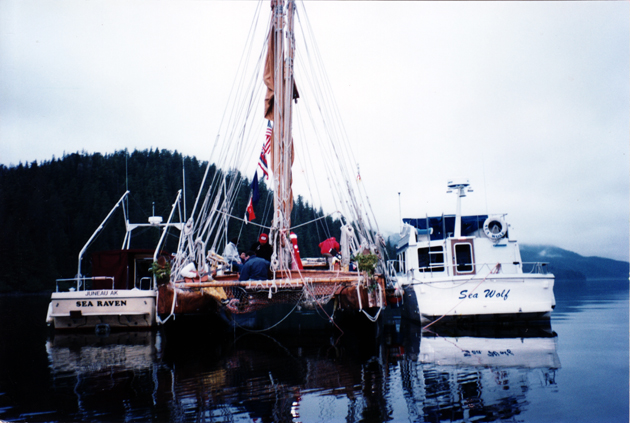
Hollis, Klawock and Craig June 27-28
Hawai'iloa left Ketchikan with the tide on June 27 at 8, for Hollis, 44 miles away, on Prince of Wales Island. The spruce trees for Hawai‘iloa’s hulls were cut on Shelikof Island in Soda Bay, on this island.
The canoe was greeted by a large crowd at the Hollis dock; that night we were hosted by the peoples of Klawock, Craig, and Hydaburg, who all came to Klawock, the closest town to the dock at Hollis.

The Welcome at the Hollis Dock
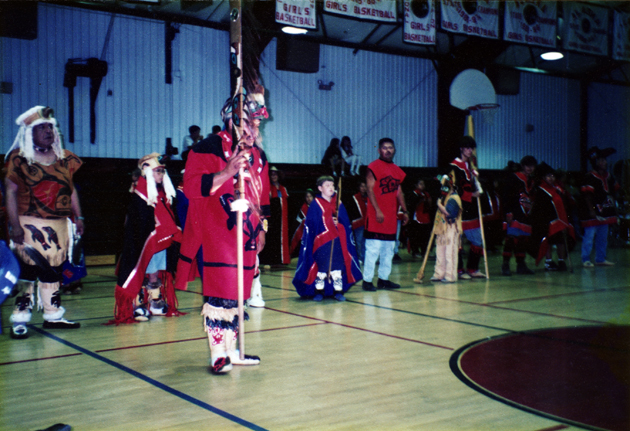
The Ceremony at Klawock Gymnasium
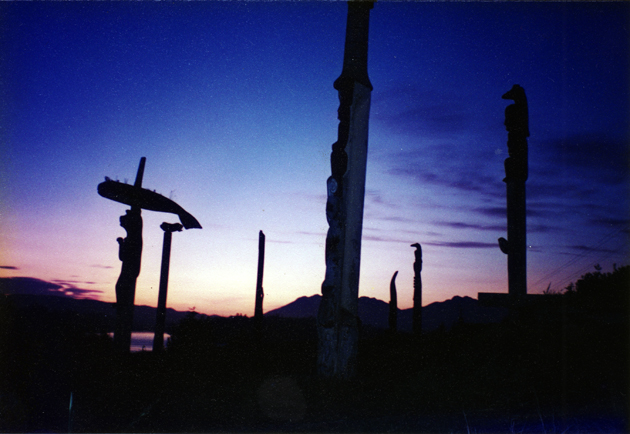
Klawock Sunset
Wrangell-Wrangell, June 29
After an overnight stay in Klawock, Hawai‘iloa continued on her journey, 104 miles to Wrangell, which is home to a small community of Tlingits. At the wharf at Wrangell, a crowd welcomed the canoe, and the crew was hosted at a dinner at the American Legion Hall.
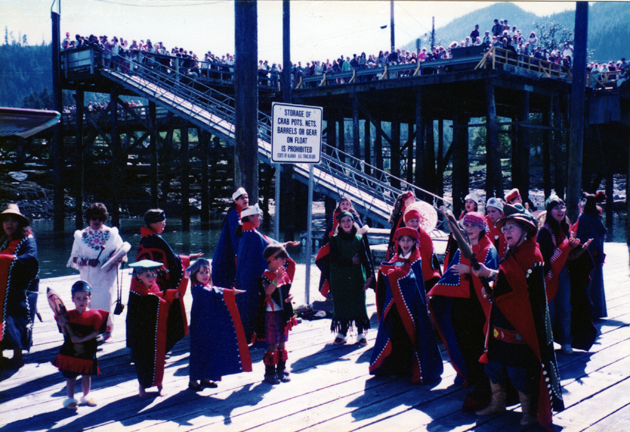
The Welcome at Wrangell Wharf
The next day, the crew went in three jet boats on a trip up the Stikine river, just north of Wrangell. On the way to a glacier, a burial island was pointed out. We stopped at a wetland where, we were told, the Tlingit lured a group of their traditional enemies, the Haida, who were accused of stealing the head of a deceased chief. The Haida canoes were stranded at low tide, and the Haida warriors were slaughtered. Biting horse flies swarmed around the three boats at the wetlands.
On the way to the glacier, our guide told us the origin story of the Tlingit: the people came from inland, toward the mouth of the Stikine River, fleeing a glacier. Two old women were sent on a raft down the river under the glacier and emerged in the area of Wrangell. The rest of the people followed and settled there.
Our guides said to look for deer, bear, and moose along the river, but we saw none.
On our way to Kake the next day, we stopped at the dock at Petersburg, on Kupreanof Island, where a small crowd had gathered to greet the canoe. The crew talked with the visitors at the brief stop before the continued on to Kake, on the opposite side of the island.
Kake, June 30-July 1
Kake is a hundred miles from Wrangell. When Hawai‘iloa arrived at 10 pm, seventeen vessels, including a single-hull fiberglass canoe built from a traditional Tlingit design, and a 55-foot seine boat carrying the Kake community dancers came out to meet her in choppy sea under a grey twilit sky. A cedar bonfire was blazing on the beach, a traditional sign that the visitors are welcome and that there was food and housing available on shore. The welcome ceremony lasted until 1 am.
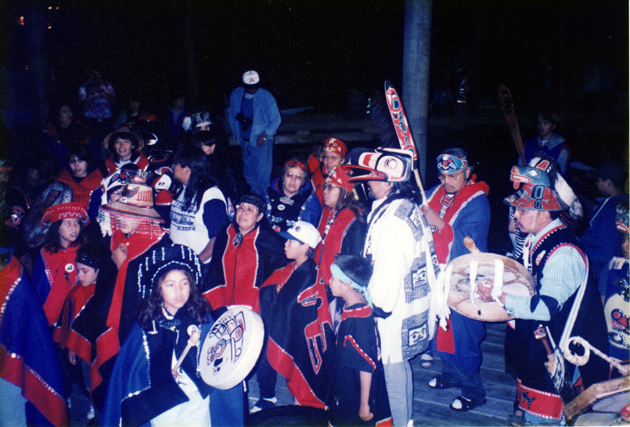
Night Welcome at Kake
The next day, Mike Jackson, a carver, took the crew on a tour of Kake.

Mike Jackson, a carver, explains the origin of the Killer Whale in front of the Killer Whale house.
Edna Jackson, Mike's wife, does beadwork art. His daughter Dawn, studying at the University of British Columbia, was home for the summer, learning to make spruce-root hats from an elder. She had just completed her first hat. The process involves pulling up spruce roots in sandy soil, leaving enough roots not to kill the tree, then splitting roots and weaving them into hat, with a checkerboard pattern around the rim.

Spruce Root Hat
Later, the crew visited a native-owned salmon hatchery.
Angoon, Alaska, July 1-2
At 1 pm on July 1, Hawai‘iloa arrived in Angoon, a Tlingit community of about 750 people. The crew was greeted by elders and dancers at dockside.

Lilikala Kame'eleihiwa Accepts a Talking Stick from a Tlingit Elder
We were told that if we wanted to see bears, the garbage dump was a good spot, as bears hang out among the wrecked cars and smoldering trash, rummaging for food. Some locals took us there in their cars and trucks: there were nine bears – five adults and four cubs – sitting on their haunches or lumbering around on all fours. One adult had his snout in a spam can. According to Fred, Jr., son of the village spokeperson of the Raven / Beaver clan, bears began coming around the dump a few years ago when there was a shortage of berries and had stayed around town ever since.
Angoon is the only permanent settlement on Admiralty Island, which is seventeen hundred-square-miles in total area. It has one of the largest concentrations of brown bears in the world. Two bears were roaming through town yesterday. The bears look friendly, almost silly, but they are known to attack people. Fred said that he couldn’t recall a bear mauling on the island, but he was apprehensive since the "garbage dump" bears, as he calls them, are no longer afraid of people. Bald eagles and ravens are everywhere.
On the way to Angoon, Hawai'iloa passed a large pod of spouting, breaching humpback whales in Frederick Sound. These whales, which spend their winters in warmer waters, like those around the Hawaiian islands, congregate in the inland passages of Alaska during the summer to feed.
The various animals of the region are represented in the highly stylized art of the native Alaskans and are an integral part of identity. Among the Tlingit, each person belongs either to the Raven or the Eagle subdivision of the tribe, and then to a clan identified by its totem, such as the Beaver or the Frog of the Raven moiety; or the Killer Whale or Bear of the Eagle moiety.
Angoon is one of the more traditional, conservative villages in Southeast Alaska. In 1882, the US Bavy shelled the island and burned the town down. The destruction took place after Tlingits took two hostages and demanded reparations (two hundred blankets) for a shaman who was killed when a bomb on a harpoon shot at a whale exploded accidentally on a Northwest Trading Company vessel. Such reparations were traditional in Tlingit culture. The company appealed to the US Navy in Sitka, which arrived in force, arrested the native leaders, demanded reparations (400 blankets) for their actions, and threatened to destroy their towns. When the natives refused to pay the reparations, the naval Commander carried out his threat.
A custom house collector from Sitka tried to justify the destruction of the town in a letter to his boss, the Secretary of the Treasury, by noting, ‘The Hoochenoos are a rich and warlike tribe, very insolent and saucy towards the whites. Not long since they proceeded to Wrangell and attacked the Church Indians there, killing several, amongst them Toyatt, a missionary Indian, a very useful and intelligent man.”
Twenty-five years ago, the elders of the village were opposed to the development of the island, including a dock for the Alaska State Ferry which runs between Juneau and Ketchikan. More recently the younger natives have been open to some development, and a ferry dock has been built.
The Hawaiian crew was warmly received and greeted as cousins by the Tlingits. Crew members were escorted to the community center to be introduced to their host families. A potlatch celebrating the arrival of the canoe was held that night.
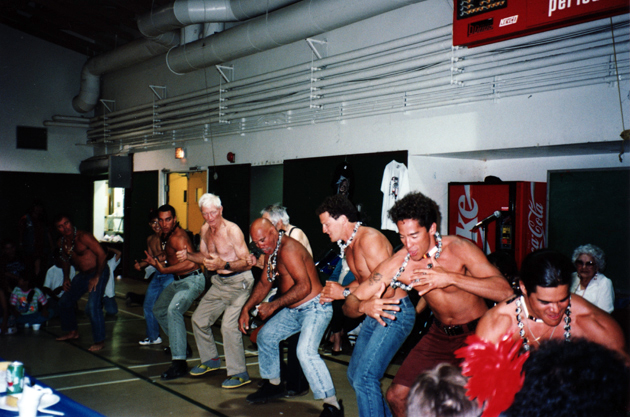
At the potlatch, Tava Taupu led the crew in a Kamapua‘a Dance from the Marquesas Islands, where Hawai‘iloa voyaged in 1995
Crew member Brad Cooper, a teacher at Kamehameha Schools in Honolulu, was hosted by Sherene Hull, a Kamehameha School alumni and an elementary school teacher in Angoon. The meeting was a reunion of sorts. During a distance learning TV program broadcasted live from Hawai'i during the 1995 voyage of Hawai‘iloa to the Marquesas, Cooper spoke about Polynesian voyaging with Hull's students in Angoon and answered their questions about life on the canoe.
In the early morning of July 2, Hawai‘iloa left for Sitka, 84 miles away, on Baranoff Island.
Sitka / July 3-5 1995
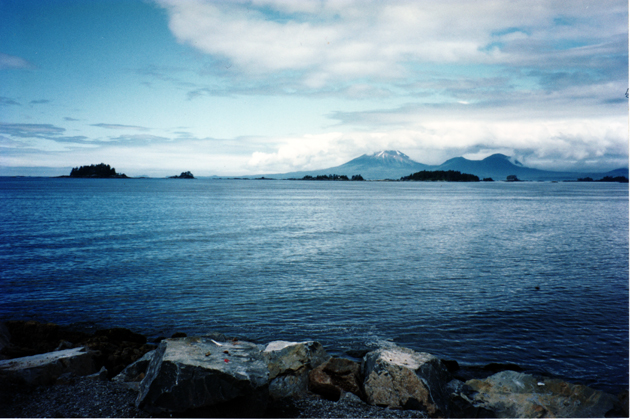
The Volcano L'ux; the Pacific Ocean lies Beyond
After a week in the inland waters of SE Alaska, Hawai‘iloa was greeted by ocean swells as it arrived in Sitka, on the Pacific Coast of Baranof Island, on the afternoon of July 3.
The Tlingit name for Baranof Island is Shee. Sitka is an anglicized version of "Shee atika," meaning "on the ocean side of Shee." The story of the naming is this: From Tongass around Ketchikan, a canoe of explorers went along the coast, looking for evergreen trees for building houses. As they neared what is today called Shee atika Sound, they saw smoke and fire coming from a mountain. (The volcano Lu'x, called Mt. Edgecumbe by settlers, on Kruzof Island to the east of Shee. The volcano is no longer active.)
They circled the island and found evergreens on the NW side. As they were cutting trees, a women dressed in white appeared. Her name was Shee. At first she objected to the Tlingits cutting her trees, but after she saw the jewelry the Tlingit women were wearing, she agreed to allow the Tlingits to stay if she was given jewelry. The larger island nearby was later settled and called Shee after the Volcano lady. Those that remained on the coast were called Shee atika, “People of the outside of Shee,” by those who had moved inland.
Elder Mark Jacobs, Jr., spoke at the welcoming ceremony of the shared seafaring heritage of the Tlingit and the Hawaiians. According to one tradition, a voyager named Kachachgook was blown off course during a storm and landed in Hawai'i. After resupplying his canoe there, he returned to SE Alaska with his paddlers, navigating by the stars and bringing with him a never-before-seen hollow plant--possibly bamboo. His first sign of landfall was smoke from the volcano L'ux.
According to Jacobs, coconut husk fiber has been found in some Tlingit artifacts. While western scholars claim the coconut was brought over by Captain Cook, Jacobs believes the fibers came from ancient contacts between the Tlingit and the Hawaiians.
A version of the story, Kaax‘ achgook, by A.P Johnson is recorded in Nora and Richard Dauenhauer’s Haa Shuka, Our Ancestors. According to this version, Kaax‘ achgook, a master hunter of sea mammals, was blown out sea by a storm while hunting and landed on an island inhabited by fur seals, sea lions and sea otters. It was a big sand island, with bamboo, but no water except in bamboo stumps broken by the wind. Kaax‘ achgook watched the heavenly bodies in the evening, Venus, the Milky Way, the sun and the moon, since they were his map. After a year he told his crew to load up supplies and the left when the handle of the Big Dipper was still visible. Kaax‘ achgook navigated by the stars back to the coast, sighting snow-capped L'ux above the waves...
Nels Lawson of the Eagle-Wolf clan said that the Tlingit once traveled and traded from Juneau to Baja California in their cedar canoes. After Western contact, the arts of canoe building, along with the people and culture of the Tlingits, began dying out. Although Lawson's uncle carved a 50-foot canoe from a huge cedar tree towed up to Sitka from British Columbia, the canoe was done for display only at the city's cultural center. The canoe was not "spread" using a traditional technique in which the cedar hull was filled with water and heated to a boil with hot stones in order to soften the wood and allow the carver to widen the beam to make the canoe more stable.

Crew Member Brad Cooper with Nels Lawson in front of the canoe his uncle carved.
Lawson was trying to get the Tlingit community to buy a fiberglass replica of a traditional canoe, which he planned to use to teach students both about their seafaring heritage and about teamwork. He hoped that the visit of Hawai‘iloa would help stir local interest in such projects.
Lawson was also an advocate for Native Studies and Language courses in the local schools. He said that currently the primary means of educating young people in the culture was an after-school program run by the Alaskan Native Brotherhood. Lawson was disappointed that young Tlingits were dependent on MacDonald's and Subway sandwiches and no longer knew much about how to live on the foods of the land and sea around them, even though many of the foods were still available. He said it would take a year of hunting, fishing, and gathering to show students the annual cycle of food production in traditional times.
He was also working on a map with native place-names.
On July 4, crew members participated in the parade through downtown Sitka, performing a haka, or dance, shirtless in the 56 degree weather, to the delight of the crowd.
On July 5, Hawai‘iloa departed for Hoonah, a native community about 140 miles from Sitka. The canoe stopped overnight in Poison Cove and arrived in Hoonah on July 6 for a three-day stay.
Hoonah, Alaska / July 6-8
Hawai'iloa sailed in a light northerly afternoon wind to the native community of Hoonah (pop. 800). As the voyaging canoe approached the town, a native canoe paddled out to greet her.
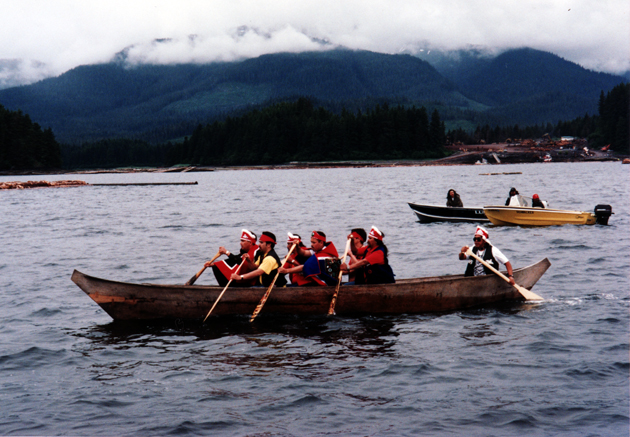
Hoonah canoe
The village elders welcomed Hawai‘iloa at the wharf.
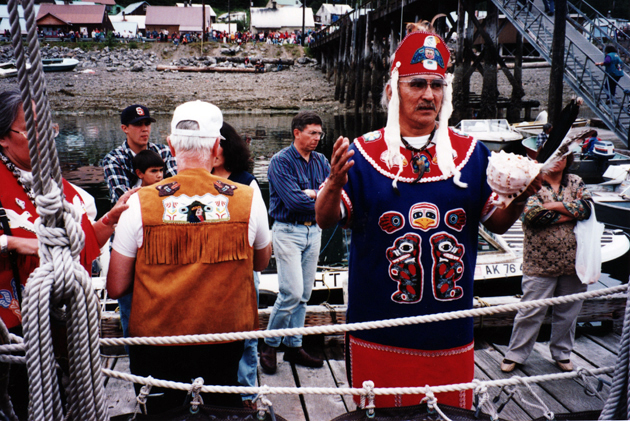
Hoonah Welcome
A seagull dance followed.

The seagull, actually the arctic tern, is the totem of one of the clans of Hoonah. The terns inhabit cliffs on the Pacific Coast of Glacier Bay National Park, the area where the four clans of Hoonah originally lived, across the Icy Strait from Hoonah. According to tradition, when terns are alerted by a sound, thousands of them swoop down and rise up again as if to greet the visitor, then return to their nests in the cliffs. Elder Richard Dalton says that the terns will even say the name of the visitor--in any language. The clan dancers imitate the motions and sounds of a seagull, crying out "It's just me."
As Hawai‘iloa entered the harbor, a 400-foot long log transport ship with four deck cranes was loading logs near tiny Pitt Island, a traditional burial site. A long float of logs ready for loading was nearby. Logging is one of the mainstays of the local economy.
The mountains around Hoonah have been cut, with wide swaths of treeless land near the shore. The spruce and cedar logs are shipped whole, mainly to Japan, which is stockpiling wood, and more recently to China and Korea. Sales to the Far East bring a premium price for timber. Despite the sparse population of the region (the whole of Alaska has about the same about of people as the island of O'ahu), the human impact on the environment has been great because of the worldwide demand for Alaska's resources.
The logging takes place on land belonging to Sealaska Corporation and the Huna Totem Corporation, which profit from the timber sales. According to elder George Obert, the native residents generally oppose the logging around their town because it destroys the habitat of deer, one of their traditional foods. Native hunters now have to travel farther to find deer. However, the board of directors of Huna Totem sold the timber in order to maximize profits for all its shareholders, the majority of whom no longer live in Hoonah.
Sealaska, the regional native corporation of Southeast Alaska, and Huna Totem Corporation, a native village corporation, were formed after the Alaska Native Claims Settlement Act (ANSCA) of 1971, which awarded cash (nearly $1 billion) and land (44 million acres) to the native peoples of Alaska for the illegal seizure of aboriginal lands by the U.S. Government. Sealaska, one of fourteen regional corporations, received 300,000 acres while 12 native villages and towns in the Southeast with at least twenty-fi ve inhabitants received 23,000 acres. (Some villages were left out; as of the summer of 1995, five more were applying for land.)
Not everyone is happy with the settlement. Frank Williams told me that because the land selected had to be contiguous to the village, the people of Hoonah were not able to take the land with the best resources, or land in their original homeland in Glacier Bay National Park. Williams also believes that the native people would not have formed profit-making corporations, as stipulated by ANCSA, if they had had a choice.
The Tlingit language and traditions have been largely lost through assimilation of the younger generation. There are no native speakers under 40 yeras of age. District School Superintendent Virginia Fryrear says that the Hoonah School is taking the lead in developing a curriculum in Tlingit language and culture. But a 35-year old Tlingit remains skeptical. Although he considers himself a radical and has developed a strong interest in his culture in the last three years, neither he nor anyone else of his generation can speak the language. "Until I see that the school can produce one Tlingit speaker, I can't say that its program will work."
At a crosscultural workshop, Lilikala Kame'eleihiwa, crew member of Hawaiiloa and Hawaiian Studies professor at UH Manoa, shared with Tlingit educators the successes of the Hawaiian Language Immersion program in Hawai'i. "It's wonderful to hear our children speaking in Hawaiian and arguing in Hawaiian. I am impressed with the immersion method and would recommend it for the teaching of any language, including Tlingit. You would have an easy time starting a school in Hoonah because you still have native s peakers among the older generation."
Before leaving Hoonah on July 9, the crew of Hawai‘iloa was given a tour of Glacier Bay National Park, west of Juneau, by four Tlingit elders. The trip was bittersweetfor the elders. One of them said it was a chance to revisit the sites of their childhood, when the Tlingits of Hoonah used to fish, hunt, and gather food in the area--their ancestral homeland before advancing glaciers drove them out. But the trip was a sad one, too, because the National Park Service prohibits hunting and gathering today, except by special permit.
Frank Williams, a full-blooded Tlingit who was born in Glacier Bay during a seagull egg gathering trip his parents made one summer, says that certain environmentalists oppose any human acitivity that will affect the wildlife and plantlife in the park. "But we lived here for 10,000 years or more, and the land was healthy. It's our tradition to protect all living things. We pray to the forest people before we take anything from their domain. It's only since the white man came that the environment has become endangered."
Williams says there is a bill before Congress to allow Tlingits to hunt, fish, and gather for subsistence in the area. To those who say that Tlingits should be allowed to hunt and fish only with traditional tools such as the bow and arrow, Williams says "That's like telling the tour operators who bring visitors to the National Park that they can only bring tourists in by canoe."
It took Williams over two years to get a permit to hunt two goats so his aunt could weave him a traditional tunic out of goat hair. It took him three days to find and shoot the two large goats needed for the tunic. Did he eat the meat? "Yes. But they were old goats and kind of tough." His aunt dyed the tunic in the traditional way, with dark brown made from hemlock bark, yellow from a moss, and blue-green made from boiling the wool with copper in urine.
Williams told me about a case pitting a Tlingit traditionalist and Park Service environmentalists. In October, 1992, Gregory O. Brown, Sr. (Tlingit name: Shaa-yakw-nook), shot a seal with a rifle upon the request of one of his uncles, who wanted the seal for a potlatch in honor of one of BrownÕs aunts. Seals are a traditional food for the Tlingit, and potlatches are considered religious ceremonies. The Park Service arrested Brown, confiscated the rifle and the seal, and charged him with taking a seal without a permit within the boundaries of Glacier Bay National Park. Brown at first asserted his native hunting and gathering rights, then religious freedom as grounds for dismissing the charges. After his lawyers questioned the right of the Park Service to enforce regulations on land it did not own below the mean high tide line in Glacier Bay, the U.S. Government dropped its prosecution of Brown at the end of 1993, not wishing to litigate the issue of ownership of submerged land in Glacier Bay at that time, although it continued to maintain it had the right to regulate all hunting and gathering within the boundaries of the national park.
Brown wanted the issues resolved, but could not find a lawyer to pursue his case. He wrote in a letter addressed to his "Hawaiian brothers and sisters": "I was given no help from all governmental entities such as the Tlingits and Haidas, Sealaska, BIA (Bureau of Indian Affairs), Huna Totem, these people only offered to pay the fine for me. I think (and its only my opinion) that these entities have a compact with the government to assimilate us Tlingits. Assimilate is just another word for GENOCIDE." He signed the letter Shaa-yakw-nook, "Tlingit Warrior."
My host was a Tlingit woman, who was married to a non-native from Oregon. He was a tall, large man, who was missing several fingers. He dressed in overalls and wore a “Mr. Fix It” hat. He worked at home doing repair jobs, “a jack of all trades and master of none,” as he said. He noted that his wife was not often at home--Friday night away at bingo, and in the daytime on call as a counselor for distressed Tlingits. She left early in the morning, including Sunday morning, the day the canoe was leaving.
One morning I sat and listened to him ramble, his life story from his boyhood in Oregon, then how he moved to California, how he had a little land there but that it wasn’t worth very much because it was next to a drive-in theater and how he sold it for what he bought it; how taxes were too high in California; how he moved to Alaska to work on a fishing boat; how fishing died out; how he planned to move back to Oregon because he missed “real seasons.”
He was an outsider in Huna. He didn’t attend any of the ceremonies for the visiting crew. He spent most of his spare time watching satellite TV. He was fixated on the fact that he was able to watch the Rodney King riots in Los Angeles live in Huna. He was against affirmative action.
He was not impressed with Tlingit culture. He talked about the tradition of slavery and cruelty. He said the last war canoe that was launched in Huna was launched over the corpses of slaves, who had been sacrificed. The chief launched the canoe at low tide so that he could use the maximum number of corpses to get the canoe into the water. The greater the sacrifice, the greater the prestige. He said that there was not much fish and wildlife in Glacier Bay and wondered why the Tlingits were making such a fuss about not being able to hunt and fish there.
I had heard the story of launching canoes over corpses before. But overall he seemed to lack knowledge or understanding of the native culture of the land he was living on.

Nainoa presented a Hawai‘iloa paddle to the people of Huna
Lincoln Island, July 9
After a farewell ceremony at the dock, Hawai‘iloa left Huna and sailed east down Icy Strait from Hoonah, then took a tow up Lynn Canal, a narrow waterway bordered by steep, jagged, snowcapped mountains.
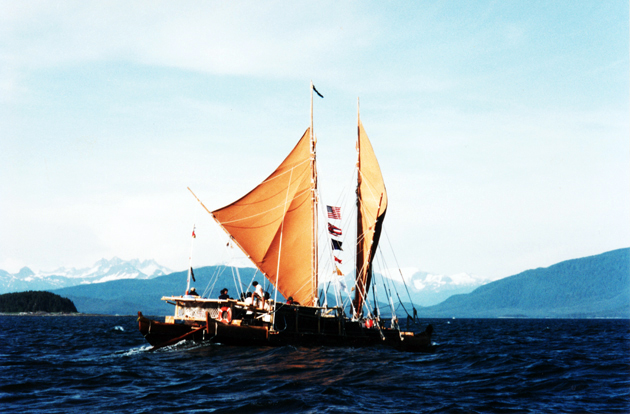
Hawai‘iloa Sailing in the Icy Strait, Alaska
The crew spent the night at Lincoln Anchorage, on an island 55 miles south of Haines.

Kala'i Miller fishing from the manu of the canoe at dawn.
Haines, Alaska, July 10-13
Hawai'iloa arrived in Haines, Alaska, at 10 am on July 10, the last stop before Juneau. The crew was welcomed by Tlingits from four communities--Haines, Kluckwan, Whitehorse, and Skagway.
The Tlingit name for Haines is Deishu--“the end of the road,” or “the beginning of the road.” It is at the north end of Lynn Channel, and at the south end of a trail that leads to inland villages.

Welcome at Haines
Haines is the hometown of Judson Brown, who was approached by his friend Herb Kawainui Kane, one of the founders of the Polynesian Voyaging Society, in 1990, about the possibility of purchasing two Alaskan logs to build Hawai‘iloa.
Brown introduced Kane to Byron Mallot, then CEO of Sealaska. Mallot, who had seen documentaries about Hokule'a, said he visualized spruce logs rising over Pacific Ocean swells as the hulls of a Hawaiian voyaging canoe and made the decision to donate the logs. "The Hawai'iloa project is in keeping with the mission of Sealaska to strengthen native cultures by looking to the past in order to find a direction for the future," Mallot explained at the welcoming ceremony.
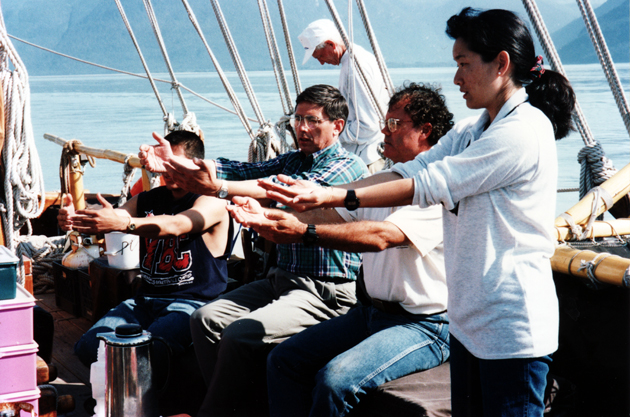
Byron Mallot, learning a hula from crew member Brad Cooper, with Dawn Gohara, on the way to Haines.
A fifteen canoe with three paddlers came out to greet Hawai‘iloa as it approached the dock. Later, at the Alaskan Native Brotherhood Hall, where a lunch was held, the carver, Wayne Price, was loading the canoe into a pick-up truck. He said he finished the canoe that morning after a couple of sleepless days, and that the paint was still wet when he launched it. He sat down with Nathan Jackson, the master carver we met in Ketchikan, who is from Klukwan and who had come home to dance at the potlatches for Hawai'iloa. Jackson sketched some canoe designs on the paper table covering and made some suggestions about carving and stretching canoes to the younger Price. Price planned to carve a larger canoe out of cottonwood. “The wood is soft and flexible,” explained Jackson. “It has some give when the hull goes up against something solid, like a rock.” Jackson himself was carving a 27-foot canoe out of cedar, and had plans to make a bigger one “The tree already has my name on it,” he said. He moved to Ketchikan to be closer to the Tongass forest, where the big trees are. “There’s more wood around there.” (The northwest canoe, single-hulled, was as long as seventy feet, with a high prow and stern.)
On July 11, at a potlatch commemorating the visit of Hawai'iloa, navigator Nainoa Thompson was honored with a new Tlingit name--Xaat eesh [Kot eesh], "Island Father." Tlingit elder Judson Brown, who bestowed the honor, explained that the name described a navigator and voyager, someone who looks for islands. Last October, Thompson had been given the name "Goosh Klein," "Big Fin," when he was adopted into the killer whale clan by Brown. "Goosh Klein" refers to the leader of a pack of killer whales.
Thompson accepted the new Tlingit name on behalf of the hundreds of people in Hawai'i who helped to build Hawai‘iloa between 1990-1993 and who sailed the canoe to Tahiti, Nukuhiva, and back to Hawai'i in the spring of 1995. He presented a koa paddle from the canoe to the city of Haines to commemorate Hawai‘iloa's visit. "This paddle is made from the same wood we sought when we first decided to build Hawai‘iloa," Thompson said. "When we couldn't find koa trees large enough in Hawai'i, we had to turn to the native people of Alaska, and you responded. This project is about bringing people together, about working together, about overcoming prejudices and divisions, and about tuming fear into hope."
Captain Wally Froiseth added, "This paddle was used to paddle the canoe into the sacred pass to Taputapuatea, the most sacred marae (site of worship) in Polynesia. The paddle is full of mana (spiritual power), and we are transfering this mana to you."
The next day, the crew of Hawai‘iloa attended a commemorative lunch at Klukwan, a native village of 135 residents, located 22 miles from Deishu up the Chilkat River Valley, situtated between the river and steep mountains. Deer, bear, and moose still roam the streets.
David Katzeek, chief of the thunderbird clan, told his guests a story about a man who found dead salmon in bits and pieces along a stream. He tried to restore a fish to life, so that salmon would come up the stream again as food for his people. Each time he removed a little bit more of the sand and bits of leaves and branches contaminating the reassembled fish until he succeeded in restoring the fish to life on the fourth try.
Katzeek said his grandfather, Jimmy George, who told him the story, gave it the following interpretation: that the bits and pieces of the salmon represented the bits and pieces left of the Tlingit culture today and that the contamination was the materialism that pervades modern life. The culture could only be restored to life through a return to the spiritual beliefs of their ancestors.
Lani Hotch, a resident of Klukwan whose father was half Hawaiian, brought out for display a half-finished Chilkat Blanket, woven of goat's hair.

One of these intricately-designed, hand-woven, storytelling blankets takes about a year to complete. The blankets are used in dances and are considered by some to be the highest expression of Tlingit art. The Chilkat River Valley, in which Klukwan is located, was famous for its weavers.
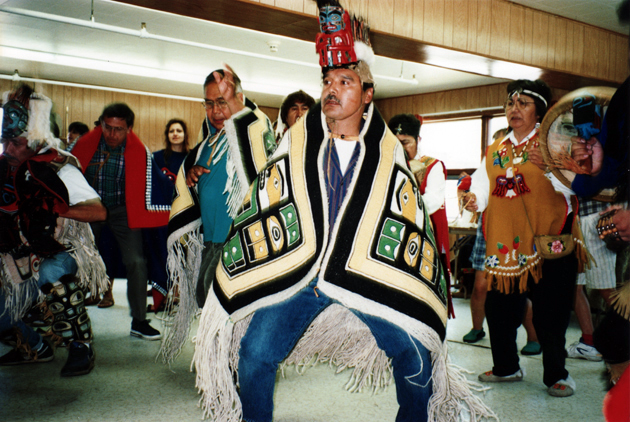
Dancer with Chilkat Blanket
The story of the search for the logs for Hawai‘iloa inspired Hotch to put the half-finished blanket on display for the Hawaiians. The last master weaver of Chilkat, Jennie Thlunaut, died in 1986. Hotch said that like the Hawaiians, the Tlingits had to look for help outside of their own people in order to begin to recover a lost art. They turned to Cheryl Samuleson, a non-native from Hawai'i, who had taken apart a blanket to analyze its intricate weave. Samuelson showed Hotch and her team of natives and non-natives how to make the blankets, and the team has been working on their first blanket ever since. Samuelson was adopted into the wolf clan of the village and periodically returns to check on the progress of the blanket. Hotch called the blanket a healing robe. Like the canoe Hawai‘iloa, the blanket has brought people together. "There have been many conflicts between natives and non-natives in Alaska," she explained. "Now is a time for healing."
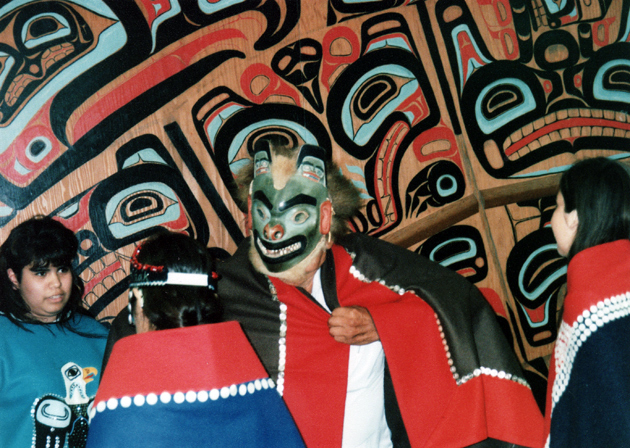
Dancer with a Bear Mask, Klukwan, Alaska

Nainoa (right) with his parents Laura and Pinky and the crew visited the bear house in Klukwan.
My host in Deishu was a elderly white woman, whose half-Tlingit husband was deceased. She had resided in Deishu for 50 years and was now retired and enjoying her travelling--she was headed for a high school reunion in Anchorage and had just returned from a doctor's appointment in Seattle. When I mention that we were going to Klukwan the next day, she offered that while she thought that the Alaska Native Claims Settlement Act was generally a good thing, she found that it has had one negative effect on the people of Klukwan, whose corporation had been paying large dividends to its shareholders, the 135 villagers: $1500 a month, tax-free, according to her. “Many of them don’t have to work and so they don’t work. Most of the people under thirty have never worked. When the older people do get jobs, they’ll show up for a couple of days and then disappear for a couple of days. They don’t have good work habits because they have never had to work.” I pointed out that many Americans have inherited enough money so that they don’t have to work. With subsistence fishing, hunting, and gathering supplying their food needs, the people of Klukwan seemed quite well off. The river had salmon, which was caught in gill nets. The villagers went out on boats every couple of hours during salmon season and pulled fish from the nets.
Because of the large dividends the Klukwan inhabitants received from their corporation, natives from other towns expressed some resentment. One resident of Huna felt that it was unfair for all the villages to have been given the same amount of land, without regard to population, since the small villages like Klukwan got more per capita than large villages like Huna. Barbara Searls, a Tlingit from Juneau, explained to me later that part of the reason for the resentment was that the large payments to Klukwan residents raised expectations of all the natives, who expected their corporations to pay similar dividends and who got frustrated and angry when they didn’t.
Hawai‘iloa departed from Haines for Juneau on July 13.
Juneau, July 14-18
Juneau, the State Capital, is located along a narrow strip of land beneath 500 foot high, forested cliffs, with ribbons of water streaming down.
It was the last stop in the northwest journey of Hawai‘iloa. The canoe arrived at 10 a.m, after spending the night at the harbor in Auke Bay. She sailed up to Sandy Beach on the shore of Gastineau Channel and anchored offshore. A crowd of several hundred , including native Alaskans and Hawaiians and other Pacific Islanders living in Juneau greeted the crew.
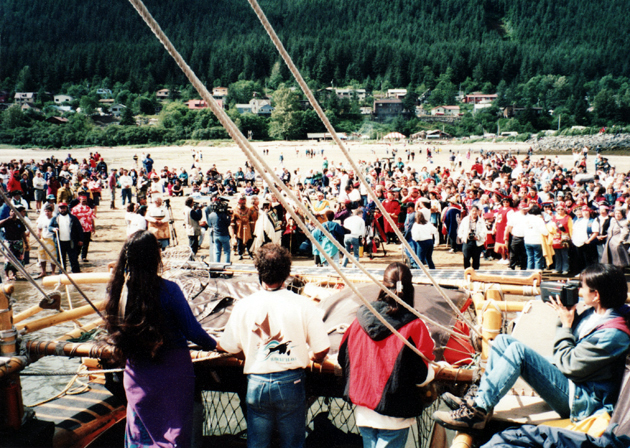
A crowd welcomed Hawai'iloa at Sandy Beach, Juenau, Alaska
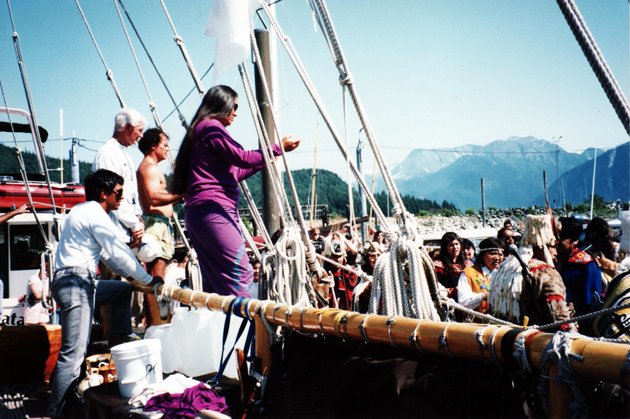
Lilikala chants in response to the welcome
After a picnic, the dedication of a replica of a Hawaiian canoe petroglyph at a native Cultural Arts Park on the Juneau waterfront, and a performance by Naa Kahidi, a world-famous native theater group, the crew attended a dinner celebration held in commemoration of Hawai‘iloa's visit.

Crew members Kalai Miller, Jarnell Martinson, and Ka'au McKenney at the petroglyph stone.
It was an evening of cultural exchange. After a performance of the Southeast Alaskan native national anthem, an elder offered the song to the Hawaiians. Myron "Pinky" Thompson, president of the Polynesian Voyaging Society, invited the native Alaskans to join the family of the canoe, which had spread throughout the Pacific and had now arrived at this far northeast corner of the rim.
Hawai‘iloa crew members had been performing Hawaiian songs and dances at each stop under the direction of Lilikala Kame'eleihiwa and Brad Cooper. Tava Taupu from Nukuhiva in the Marquesas led the male crew and men from Juneau in a shirtless dance about the pig-god Kamapua'a. The Hawaiians were adopted into the Eagle/Raven Dancers under Agnes Bellinger, and performed Tlingit songs and dances. Two young crew members--Kala'i Miller and Kapono Aluli--because of their exuberant dancing, were asked to join the Haida Dancers in their performance. The Mark Trail Dancers serenaded the entire crew.
Robert Martin, chairman of Goldbelt, a native corporation, spoke about Tlingit voyaging traditions along the Pacific Coast and suggested the Hawaiians might be able to help the Tlingits in recovering those traditions. Leo Barlow, CEO of Sealaska, noted that there were already plans to build a traditional canoe in his hometown of Wrangell, Alaska.
Byron Mallot, the former CEO of Sealaska, gave his Tlingit name "Dook da Naik" to Nainoa Thompson, and adopted Thompson into the Raven/Humpback Salmon clan. Dook Da Naik was the name of a Tlingit hero who helped his people drive the Russians from Yakutat, an area on the Pacific coast west of Glacier Bay National Park.
In responding to Mallot, Thompson spoke emotionally about what the last five years of building and sailing Hawai‘iloa meant to him and the Hawaiian community. He noted that Hawai‘iloa was not just about canoes and sailing, it was also about reviving and perpetuating traditional values. "We have been overwhelmed since coming here by your generosity and hospitality, your willingness to give. What the native Alaskans and Hawaiians have in common are their values of caring and sharing. The project is also about achievement and pride. By taking risks and reaching our goals we raise our self-esteem, and that makes everyone healthier."
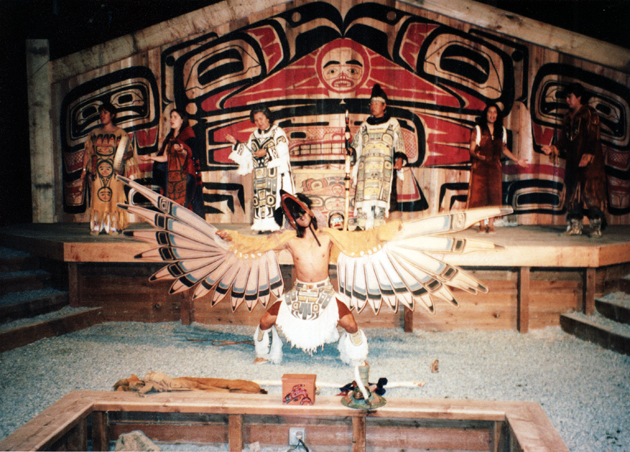
Naa Kahidi, a native theater group performed raven stories at the Juneau Cultural Arts Park
Sealaska owns one of the more striking buildings in Juneau, a city of about 30,000 people. It's a modern four-story structure, adorNed inside with totem poles, masks, wood carvings, and Chilkat blankets. It also has a replica of a Hawaiian voyaging canoe. A seminar was presented for the crewmembers concerning some of the major issues facing Tlingit communities throughout Southeast.
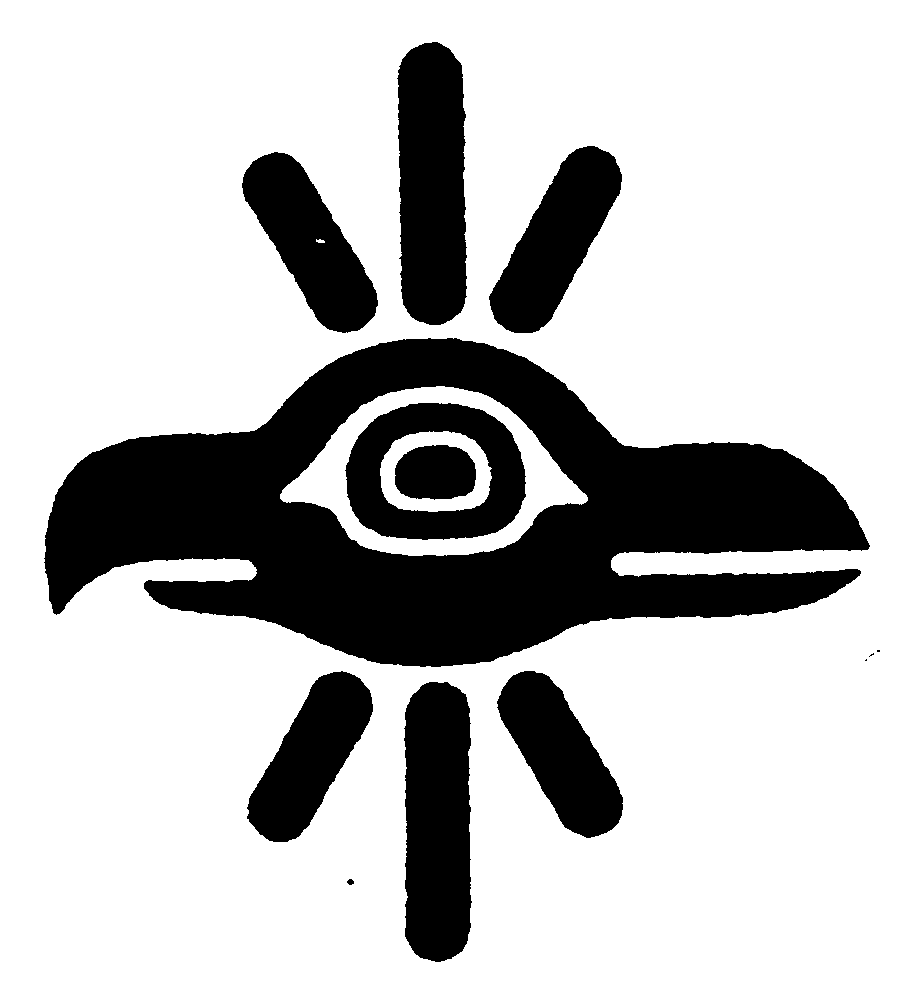
Language: Nora and Richard Dauenhauer presented their translation work. In their introduction to “Tlingit Oral Narratives,” they speak of Tlingit as a language doomed in its oral form, a language to be preserved in its written form like Latin and ancient Greek. Hence their emphasis on the text. The natives had not adopted the immersion method of indigenous language preservation and perpetuation developed in Aotearoa and adopted in Hawai‘i.
One speaker pointed out that the public school system in Alaska hadn’t strongly support native language and cultural studies, except in elementary schools. The assumptions were racist – that nonwhite people and their culture are simple and child-like; that western culture was for older students and adults. Even something as simple as naming a new middle school in Tlingit (the norm in Hawai’i is to give new public buildings and schools Hawaiian names) brings out resistance. “Racist sentiments came out,” said one Juneau resident. The white community resisted the naming. White school children turned the Tlingit name into an obscene white phrase. Ignorance abounds.
One speaker urged the Hawaiians to work toward inclusion under Federal law as Indians, so that they could receive the same benefits as Native Americans. Lilikala, director of Hawaiian Studies at UH Manoa, pointed out that the Tlingits had no political control over their land and that what she and other Hawaiians wanted was sovereignty--an independent nation, not a nation within a nation. Kame‘eleihiwa wasn’t sure about the specifics of this independent nation, but added, “We need to think these things through, not close off our options now.”
Hawai‘iloa was in Juneau until July 18, when it was barged to Seattle for shipping back to Hawai'i. The barging from Juneau to Seattle was donated by Alaska Marine Lines; the barging from Seattle to Honolulu was donated by Aloha Cargo Transport.


